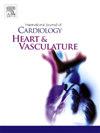经导管主动脉瓣植入术患者左心房僵硬度的预后价值。
IF 2.5
Q2 CARDIAC & CARDIOVASCULAR SYSTEMS
引用次数: 0
摘要
目的:本研究旨在评估经导管主动脉瓣植入术(TAVI)患者左心房(LA)僵硬度与预后之间的关系。方法和结果:本研究纳入2015年至2023年在熊本大学医院接受TAVI治疗的279例主动脉瓣狭窄(AS)患者。在中位随访468天(四分位数间距:258-825天)期间,发生42例死亡。tavi前超声心动图显示,全因死亡组LA僵硬指数(E/ E′比值/储层期LA应变[LASr])明显高于生存组(2.80±2.56 vs. 1.70±1.23),p主动脉瓣速度、心房颤动、对数转换高敏感心肌肌钙蛋白T(风险比[HR]: 1.31, 95%可信区间[CI]: 1.14-1.51, p。对于接受TAVI的AS患者,即使在调整了多个预测因素后,LA刚度的估计也具有重要的预后价值。本文章由计算机程序翻译,如有差异,请以英文原文为准。
Prognostic value of left atrial stiffness in patients undergoing transcatheter aortic valve implantation
Aim
This study was performed to evaluate the association between left atrial (LA) stiffness and outcomes in patients undergoing transcatheter aortic valve implantation (TAVI).
Methods and Results
This study involved 279 patients with aortic stenosis (AS) who underwent TAVI at Kumamoto University Hospital between 2015 and 2023. During a median follow-up of 468 days (interquartile range: 258–825 days), 42 deaths occurred. Pre-TAVI echocardiography showed that the LA stiffness index (E/e′ ratio/LA strain during the reservoir phase [LASr]) was significantly higher in the all-cause death group than in the survival group (2.80 ± 2.56 vs. 1.70 ± 1.23, p < 0.01). Multivariate Cox proportional hazard analysis identified LA stiffness as significantly and independently associated with all-cause death after adjusting for body mass index, trans-aortic valve velocity, atrial fibrillation, log-transformed high-sensitivity cardiac troponin T (hazard ratio [HR]: 1.31, 95 % confidence interval [CI]: 1.14–1.51, p < 0.01), tricuspid regurgitation, left ventricular global longitudinal strain (HR: 1.24, 95 % CI: 1.06–1.44, p < 0.05), and LASr (HR: 1.27, 95 % CI: 1.05–1.60, p < 0.05). Receiver operating characteristic analysis showed that the optimal cutoff value of the LA stiffness index for predicting all-cause mortality was 1.69 (sensitivity: 60 %, specificity: 62 %, area under the curve: 0.64). Kaplan–Meier analysis demonstrated that patients with a high LA stiffness index (≥1.69) had a significantly higher probability of all-cause death (p < 0.05).
Conclusion
Estimation of LA stiffness provides significant prognostic value in patients with AS undergoing TAVI, even after adjusting for multiple predictive factors.
求助全文
通过发布文献求助,成功后即可免费获取论文全文。
去求助
来源期刊

IJC Heart and Vasculature
Medicine-Cardiology and Cardiovascular Medicine
CiteScore
4.90
自引率
10.30%
发文量
216
审稿时长
56 days
期刊介绍:
IJC Heart & Vasculature is an online-only, open-access journal dedicated to publishing original articles and reviews (also Editorials and Letters to the Editor) which report on structural and functional cardiovascular pathology, with an emphasis on imaging and disease pathophysiology. Articles must be authentic, educational, clinically relevant, and original in their content and scientific approach. IJC Heart & Vasculature requires the highest standards of scientific integrity in order to promote reliable, reproducible and verifiable research findings. All authors are advised to consult the Principles of Ethical Publishing in the International Journal of Cardiology before submitting a manuscript. Submission of a manuscript to this journal gives the publisher the right to publish that paper if it is accepted. Manuscripts may be edited to improve clarity and expression.
 求助内容:
求助内容: 应助结果提醒方式:
应助结果提醒方式:


